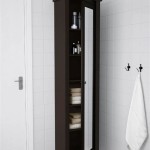DIY Refinish Mirror Frame
A beautifully framed mirror can elevate the aesthetics of any room. Over time, however, mirror frames can become worn, chipped, or simply outdated. Refinishing a mirror frame is a cost-effective way to revitalize a piece and customize it to match existing decor. This process requires patience and attention to detail, but the results can be highly rewarding.
Before beginning the refinishing process, it's essential to gather the necessary tools and materials. These typically include screwdrivers (for removing the mirror from the frame), sandpaper in various grits (for smoothing surfaces), drop cloths or old newspapers (for protecting work surfaces), painter's tape (for masking off areas), primer, paint or stain, sealant, and brushes or applicators suitable for the chosen finish. Safety glasses and gloves are recommended for protection during the process.
The first step in refinishing a mirror frame is preparing the surface. This begins with carefully removing the mirror from the frame. If the mirror is glued in place, a putty knife might be necessary to gently pry it loose. Once removed, the mirror should be stored safely away from the work area to prevent accidental damage. Next, any existing hardware, such as hanging brackets or decorative elements, should be removed from the frame.
Once the frame is bare, the next step is to clean it thoroughly. A mild detergent solution can be used to remove dust, dirt, and grime. For stubborn residue or built-up wax, a stronger cleaner, such as denatured alcohol, may be required. After cleaning, the frame should be rinsed thoroughly with clean water and allowed to dry completely.
The next stage involves sanding the frame to create a smooth surface for the new finish to adhere to. Start with a coarser grit sandpaper (around 100-grit) to remove any existing finish, such as paint or varnish. Gradually progress to finer grits (150-grit, then 220-grit) to smooth out any imperfections and create a uniform surface. Between each grit, wipe the frame with a tack cloth to remove sanding dust.
Once the frame is sanded smooth, apply a layer of primer. Primer helps the new finish adhere better and provides a more even and consistent final look. Choose a primer appropriate for the material of the frame and the type of finish being applied. Allow the primer to dry completely according to the manufacturer’s instructions.
After the primer has dried, the next step is applying the chosen finish. This could be paint, stain, or a combination of both. If using paint, apply thin, even coats, allowing each coat to dry completely before applying the next. For a smoother finish, lightly sand between coats with fine-grit sandpaper (220-grit or higher). If using stain, apply it according to the manufacturer's instructions, paying attention to even application and drying times.
Once the desired finish has been achieved, applying a sealant is crucial for protecting the frame and enhancing its longevity. Sealants come in various sheens, from matte to high gloss, allowing for customization to match the desired aesthetic. Apply the sealant in thin, even coats, allowing each coat to dry completely before applying the next. Follow the manufacturer’s instructions for drying times and application techniques.
After the sealant has dried and cured completely, the final step is reassembling the mirror. Carefully place the mirror back into the frame, securing it using appropriate adhesives or the original fastening method. Reattach any hardware that was removed earlier, such as hanging brackets or decorative elements. Once reassembled, the refinished mirror is ready to be displayed and enjoyed.
Different types of frames require specific approaches. Wooden frames are commonly refinished with paint or stain, while metal frames might benefit from specialized metal paints or finishes. Plastic frames can be painted, but adhesion can be challenging, so using a primer specifically designed for plastic is recommended. Understanding the material of the frame and selecting appropriate products and techniques is essential for achieving a successful and long-lasting finish.
Refinishing a mirror frame can significantly enhance its appearance and extend its lifespan. While the process requires several steps and careful attention to detail, it is a project that most individuals can undertake with the right tools and materials. By following the steps outlined and selecting appropriate products for the frame material, one can transform an old or outdated mirror into a revitalized piece that complements any decor.

Easy Chippy Painted Mirror Diy Hallstrom Home

Spray Painted Gold Yard Mirror How To Paint A Frame

How To Paint A Mirror Meg Del Design Furniture Diy Blog

Painting A Mirror Frame Easy Yet Stunning Ideas Girl In The Garage

How To Paint A Mirror Frame Gold Easily In Two Steps

How To Paint Gold Mirror Frame Keeping The Ornate Features Vickymyerscreations

How To Spray Paint A Mirror Frame Perfect Beginner Diy Project Design Morsels

How To Paint A Mirror Frame Gold Remodelando La Casa

How To Paint A Mirror Frame

Painting A Mirror Frame Easy Yet Stunning Ideas Diy Frames








